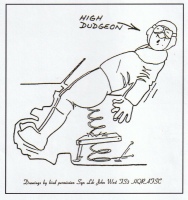High Dudgeon
The original of this story appeared in "Flight Safety” magazine, and we think you’ll agree that it’s a fascinating tale ....…
How many of you have described yourself or a friend / acquaintance as “in a state of high dudgeon”? Do you know what the dictionary gives us as the definition of the expression? Webster‘s English Dictionary tells us that it is: a feeling of offence or resentment - anger (origin unknown). Origin unknown? Well, read on ..…
Flying Officer Peter William Archdale Dudgeon was a pilot serving with Number 208 Squadron at the time that the Squadron was in the process of converting from the old and rather sluggish Bristol F28 Fighter (affectionately known as the Brisfit or “Biff") to the new and much faster Armstrong-Whitworth Atlas, an aircraft capable of exceeding 200 mph in a dive. Flying Officer Dudgeon was concerned that the effect of the airstream was to hold aircrew in their seats, so making a conventional escape from a crippled aircraft more difficult - even impossible in some circumstances. So our ingenious Mr Dudgeon came up with a brilliant idea to put the escapee into a position whereby he could exit the aircraft safely. His idea was a spring-loaded seat, mounted on concentric sliding tubes, each with a strong spring inside. The springs were compressed on a ratchet and held in place by a catch.
in some circumstances. So our ingenious Mr Dudgeon came up with a brilliant idea to put the escapee into a position whereby he could exit the aircraft safely. His idea was a spring-loaded seat, mounted on concentric sliding tubes, each with a strong spring inside. The springs were compressed on a ratchet and held in place by a catch.
The operation of the Dudgeon seat was simplicity itself - the occupant of the seat (there were two of course in the Atlas), when faced with an emergency that demanded departure, would simply release the catch and the seat would rapidly lift him to a position where climbing free of the aircraft was easy and he would bale out. An early form of ejector seat.
Dudgeon made a scale model of his seat for demonstration to the Air Ministry and submitted it with a set of drawings for installing the full-size version into an Atlas. Perhaps hardly surprisingly, the idea was turned down. It seems that a World War One attitude prevailed, that if aircrew had the opportunity to abandon the aircraft when they faced danger, or return it to base if it was severely damaged, they would be more likely to avoid danger and abandon. Our pilot would certainly be in a state of some anxiety and it may be this state of excitement that gave the foundation to the later expression. So remember when you describe someone as in a state of ‘high dudgeon’ in the future, you got it from a fellow on 208 Squadron! So the term “high dudgeon" has its origin in a completely different context from which it is used today. Interesting how phrases come about, don't you think?
made a scale model of his seat for demonstration to the Air Ministry and submitted it with a set of drawings for installing the full-size version into an Atlas. Perhaps hardly surprisingly, the idea was turned down. It seems that a World War One attitude prevailed, that if aircrew had the opportunity to abandon the aircraft when they faced danger, or return it to base if it was severely damaged, they would be more likely to avoid danger and abandon. Our pilot would certainly be in a state of some anxiety and it may be this state of excitement that gave the foundation to the later expression. So remember when you describe someone as in a state of ‘high dudgeon’ in the future, you got it from a fellow on 208 Squadron! So the term “high dudgeon" has its origin in a completely different context from which it is used today. Interesting how phrases come about, don't you think?
This article first appeared in the 2004 Association Magazine.





